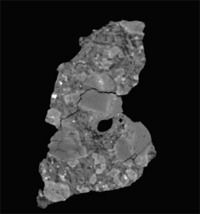by
Loren Bonner, DOTmed News Online Editor | June 03, 2013

CT scans reveal
an air space, in black,
on a meteorite
(Courtesy: Natural History Museum, London)
The Natural History Museum in London thinks CT scans might gives us some clues as to whether there was ever life on Mars.
NASA's rover Curiosity landed on Mars in early August. It's expected to spend two years examining the terrain and collecting critical information about the large crater it now calls home. But many question remain, including figuring out the best way to study these precious objects once they're returned to earth. Scientists from the Natural History Museum in London, working with colleagues at the European Space Agency and the UK Space Agency, think CT is one effective method that could be used to gather critical information from these Martian samples brought back from missions.
The museum holds a world-class collection of 13 meteorites. CT scans performed on these rare rocks have revealed fine details such as voids, or air spaces, at the center of the meteorite. CT scanning is also non-destructive. Traditional methods involve studying the meteorite with an electron microscope, which requires small samples to be broken off and coated with a layer of carbon.



Ad Statistics
Times Displayed: 67868
Times Visited: 2217 Ampronix, a Top Master Distributor for Sony Medical, provides Sales, Service & Exchanges for Sony Surgical Displays, Printers, & More. Rely on Us for Expert Support Tailored to Your Needs. Email info@ampronix.com or Call 949-273-8000 for Premier Pricing.
"Micro-CT has become an incredibly powerful tool over the last 10 years," said Dr. Farah Ahmed, the museum's CT facility manager and specialist. "With its non-destructive nature and highly detailed imaging, CT scanning has proven to be a successful technique in a museum environment."
Scientists at the museum praise CT for being able to see a high level of detail.
Seven meteorites have been scanned at the museum so far, as part of a space mission project. The museum says that the CT scans are producing important data and have been impressing crowds at international conferences.

